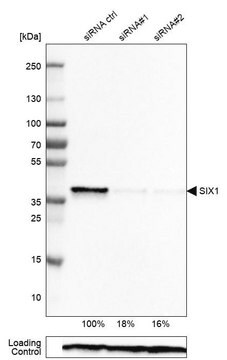03-108
RIPAb+ Fragile X Mental Retardation Protein - RIP Validated Antibody and Primer Set
from mouse
Synonym(s):
Fragile X mental retardation 1 protein
About This Item
Recommended Products
biological source
mouse
Quality Level
clone
monoclonal
species reactivity
human, rat, mouse
manufacturer/tradename
RIPAb+
Upstate®
technique(s)
ELISA: suitable
RIP: suitable
immunocytochemistry: suitable
immunohistochemistry (formalin-fixed, paraffin-embedded sections): suitable
immunoprecipitation (IP): suitable
western blot: suitable
isotype
IgG1κ
NCBI accession no.
UniProt accession no.
shipped in
dry ice
General description
Specificity
Immunogen
Application
Representative lot data.
Mouse E17 spinal cord lysate (Lane 1), Mouse E16 brain (Lane 2) and NIH/3T3 lysate (Lane 3) were resolved by electrophoresis, transferred to PVDF membrane and probed with anti-Fragile X Mental Retardation Protein (1:500 dilution of a previous lot).
Proteins were visualized using a goat anti-mouse secondary antibody conjugated to HRP and a chemiluminescence detection system.
Arrow indicates Fragile X Mental Retardation Protein (~71 kDa) (Please see figures).
Immunohistochemistry: Frozen and paraffin sections. 1:500-1:5,000 dilution of a previous lot was used.
ELISA: A 1:500-1:5,000 dilution of a previous lot was used in ELISA.
Detection of FMRP on Blood Smears: A 1:500-1:5,000 dilution of a previous lot was used.
Immunocytochemistry: A 1:500-1:5,000 dilution of a previous lot was used on transfected cells. Light fixation (2% PFA, permeabilize with 0.1% triton in block only) (Please see figures).
Optimal working dilutions must be determined by the end user.
Epigenetics & Nuclear Function
Neuroscience
RNA Binding Protein (RBP)
RNA Metabolism & Binding Proteins
Neurodegenerative Diseases
Packaging
Quality
RIP Lysate prepared from NIH/3T3 cells (2 x 107 cell equivalents per IP) were subjected to immunoprecipitation using 5 µL of either a normal mouse IgG or 5 µL of Anti-Fragile X Mental Retardation Protein antibody and the Magna RIP® RNA-Binding Protein Immunoprecipitation Kit (Cat. # 17-700).
Successful immunoprecipitation of Fragile X Mental Retardation Protein-associated RNA was verified by qPCR using RIP Primers Iqsec1 (Please see figures).
Please refer to the Magna RIP (Cat. # 17-700) or EZ-Magna RIP (Cat. # 17-701) protocol for experimental details.
Target description
Physical form
Normal Mouse IgG.
One vial containing 125 μg of purified mouse IgG in 125 µL of storage buffer containing 0.1% sodium azide. Store at -20°C.
RIP Primers, Iqsec1.
One vial containing 75 μL of 5 μM of each primer specific for mouse Iqsec1.
Store at -20°C.
FOR: GCG TCT AGG ACC TTG TGA GC
REV: GAA GGC TGA CCT CCA TGT TG
Storage and Stability
Handling Recommendations: Upon receipt, and prior to removing the cap, centrifuge the vial and gently mix the solution. Aliquot into microcentrifuge tubes and store at -20°C. Avoid repeated freeze/thaw cycles, which may damage IgG and affect product performance.
Analysis Note
Includes negative control mouse IgG antibody and control primers specific for mouse Iqsec1.
Legal Information
Disclaimer
Storage Class Code
10 - Combustible liquids
Regulatory Listings
Regulatory Listings are mainly provided for chemical products. Only limited information can be provided here for non-chemical products. No entry means none of the components are listed. It is the user’s obligation to ensure the safe and legal use of the product.
JAN Code
03-108:
Certificates of Analysis (COA)
Search for Certificates of Analysis (COA) by entering the products Lot/Batch Number. Lot and Batch Numbers can be found on a product’s label following the words ‘Lot’ or ‘Batch’.
Already Own This Product?
Find documentation for the products that you have recently purchased in the Document Library.
Our team of scientists has experience in all areas of research including Life Science, Material Science, Chemical Synthesis, Chromatography, Analytical and many others.
Contact Technical Service